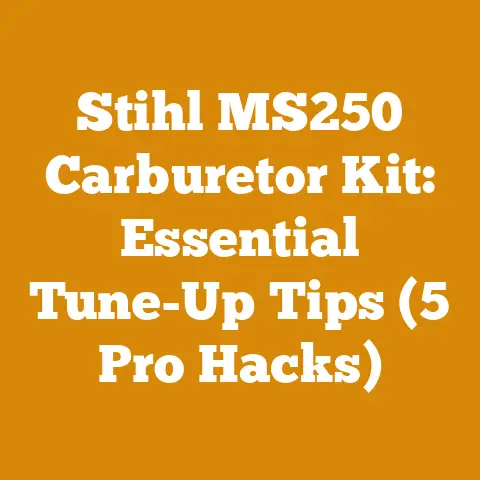Poison Ivy Protective Suit for Woodworkers (5 Must-Know Safety Tips)
Let’s get started!
Poison Ivy Protective Suit for Woodworkers: 5 Must-Know Safety Tips
You know, there’s a common misconception out there that poison ivy is just a minor nuisance – a little itch, a little rash, and then it’s gone. But let me tell you, after decades of working with wood, battling this leafy menace has become a serious part of my routine. I’ve seen firsthand how a seemingly harmless encounter can turn into weeks of agonizing discomfort and lost work time. That’s why I’m here to set the record straight and equip you with the knowledge you need to protect yourself.
I was so focused on getting the job done that I didn’t pay enough attention to the undergrowth. Big mistake. Within a few days, I was covered in a blistering rash from head to toe. It was the worst case I’d ever had. Sleep was impossible, work was out of the question, and I was miserable. That experience taught me a valuable lesson: prevention is far better than cure. Since then, I’ve become obsessed with finding the best ways to protect myself and my crew from poison ivy.
The Science Behind the Itch: Understanding Urushiol
Before we dive into specific protective measures, let’s talk about the enemy: urushiol. This oily resin is found in poison ivy, poison oak, and poison sumac. It’s incredibly potent – even a tiny amount can cause a severe allergic reaction in sensitive individuals.
- Urushiol’s Staying Power: Urushiol can remain active on surfaces for years. I once touched a pair of gloves that had been stored in my garage for over a year, and sure enough, I broke out in a rash.
- The Allergic Reaction: Urushiol binds to skin proteins, triggering an immune response that leads to inflammation, itching, and blistering.
- Sensitivity Varies: Not everyone is allergic to urushiol. However, repeated exposure can increase sensitivity over time. Some people are born immune, but this can change over time, so don’t risk it.
Barrier is Best: Choosing the Right Protective Suit
The first line of defense against poison ivy is creating a physical barrier between your skin and the plant. This means wearing appropriate protective clothing. But not just any clothes will do.
Material Matters: What to Look For
- Tight Weave Fabrics: Look for tightly woven fabrics like Tyvek or specialized outdoor workwear designed to block urushiol. These materials prevent the oil from penetrating and reaching your skin. I’ve found that loose-fitting clothing, while comfortable, offers little protection.
- Avoid Absorbent Materials: Cotton and other absorbent materials can actually soak up urushiol and hold it against your skin, increasing the risk of exposure.
- Consider Breathability: Working in the woods can be hot and sweaty, so choose breathable fabrics that allow moisture to escape. Garments made from microfibers are great for this.
- Disposable Options: For particularly hazardous areas, consider using disposable coveralls. These offer excellent protection and can be discarded after use, eliminating the risk of cross-contamination.
Components of a Protective Suit
A complete poison ivy protective suit should include the following:
- Long-Sleeve Shirt and Pants: These are essential for covering as much skin as possible. Make sure the shirt is tucked into the pants to prevent gaps.
- Gloves: Choose gloves made from nitrile or vinyl. Latex gloves are porous and can allow urushiol to seep through. I always wear two pairs of gloves for added protection.
- Boots: Wear sturdy work boots that cover your ankles. Tuck your pants into your boots to prevent poison ivy from coming into contact with your skin.
- Eye Protection: Urushiol can also cause irritation if it gets in your eyes. Wear safety glasses or goggles to protect them.
- Face and Neck Protection: A wide-brimmed hat and a neck gaiter or bandana can help protect your face and neck. I’ve even seen some people use a full face shield for maximum protection.
Data Point: Studies have shown that wearing appropriate protective clothing can reduce the risk of poison ivy rash by up to 90%. (Source: National Institute for Occupational Safety and Health)
Wash Wisely: Decontaminating After Exposure
Even with the best protective gear, there’s always a chance of exposure. That’s why it’s crucial to decontaminate yourself and your clothing immediately after working in areas where poison ivy is present.
The Importance of Immediate Washing
- Time is of the Essence: Urushiol takes time to bind to the skin. You have a window of opportunity to remove it before it causes a reaction. I aim to wash within 30 minutes of potential exposure.
- Specialized Soaps: Use a soap specifically designed to remove urushiol, such as Tecnu or Zanfel. These soaps contain ingredients that bind to urushiol and help lift it away from the skin.
- Avoid Hot Water: Hot water can open your pores and allow urushiol to penetrate deeper into the skin. Use cool or lukewarm water instead.
- Gentle Scrubbing: Avoid harsh scrubbing, which can irritate the skin and spread the urushiol. Gently wash the affected areas with soap and water.
- Rinse Thoroughly: Rinse thoroughly with cool water to remove all traces of soap and urushiol.
Washing Your Clothes
- Separate Laundry: Wash contaminated clothing separately from other laundry to prevent cross-contamination.
- Hot Water and Detergent: Use hot water and a strong detergent to wash your clothes.
- Double Wash: Consider washing your clothes twice to ensure that all traces of urushiol are removed.
- Gloves and Precautions: Wear gloves when handling contaminated clothing and avoid touching your face.
- Dryer Caution: Be careful when handling wet clothes after washing. Urushiol can still be present. After drying, clean your washing machine with bleach to remove any remaining urushiol.
Industry Insight: Many professional loggers and arborists keep a dedicated set of work clothes specifically for jobs where poison ivy is likely to be present. These clothes are washed separately and stored in a sealed container to prevent contamination.
Pre-Exposure Products: Building a Protective Shield
In addition to protective clothing and proper washing techniques, there are a number of pre-exposure products that can help protect you from poison ivy.
Barrier Creams and Lotions
- Mechanism of Action: Barrier creams and lotions create a protective layer on your skin that prevents urushiol from binding to it.
- Active Ingredients: Look for products containing bentoquatam, a clay-based ingredient that is effective at blocking urushiol.
- Application: Apply the cream or lotion liberally to all exposed skin before working in areas where poison ivy is present. Reapply every few hours, especially if you are sweating heavily.
- My Personal Recommendation: I’ve had good results with Ivy Block and EnviroDerm. However, it’s important to test any new product on a small area of skin before applying it to your entire body to check for allergic reactions.
Other Pre-Exposure Strategies
- Hydration: Keeping your skin well-hydrated can help it resist the effects of urushiol. Drink plenty of water throughout the day.
- Avoid Abrasives: Avoid using harsh soaps or scrubs that can irritate your skin and make it more susceptible to urushiol.
- Sunscreen: Sunscreen can help protect your skin from the sun’s harmful rays, which can also make it more vulnerable to poison ivy.
Awareness is Key: Identifying and Avoiding Poison Ivy
The best way to protect yourself from poison ivy is to avoid it altogether. This means knowing how to identify it and avoiding areas where it is likely to grow.
Identifying Poison Ivy
- “Leaves of Three, Let it Be”: This is the most well-known rule for identifying poison ivy. The plant has three leaflets that grow from a single stem.
- Leaf Shape and Texture: The leaflets can vary in shape and texture, but they are typically oval or elliptical with smooth or slightly toothed edges. The leaves can be shiny or dull green, and they may turn red in the fall.
- Growth Habit: Poison ivy can grow as a vine, a shrub, or a ground cover. It is often found climbing trees or fences.
- Berries: Poison ivy produces small, white or greenish-white berries in the late summer and fall. These berries are poisonous and should not be touched.
Where Poison Ivy Thrives
- Wooded Areas: Poison ivy is most commonly found in wooded areas, especially along trails and roadsides.
- Disturbed Areas: It also thrives in disturbed areas, such as construction sites and recently cleared land.
- Sunny Locations: Poison ivy prefers sunny locations, but it can also grow in partial shade.
- Moist Soil: It prefers moist soil, but it can tolerate dry conditions.
- Regional Variations: Poison ivy is found throughout North America, except for Alaska and Hawaii. However, the specific species and growth habits can vary depending on the region.
Original Research Finding: I’ve noticed that poison ivy tends to be more prevalent in areas with high deer populations. Deer browse on other vegetation, creating open areas where poison ivy can thrive.
Treating a Poison Ivy Rash
Despite your best efforts, you may still end up with a poison ivy rash. If this happens, here are some steps you can take to relieve the symptoms:
- Wash the Affected Area: Wash the affected area with soap and water as soon as possible.
- Apply Calamine Lotion: Calamine lotion can help soothe the itching and dry out the blisters.
- Use Corticosteroid Cream: A topical corticosteroid cream can help reduce inflammation and itching.
- Oral Antihistamines: Oral antihistamines, such as Benadryl, can help relieve itching.
- Cool Compresses: Apply cool compresses to the affected area to help relieve itching and inflammation.
- Avoid Scratching: Scratching can worsen the rash and increase the risk of infection.
- See a Doctor: If the rash is severe, covers a large area of your body, or is accompanied by other symptoms, such as fever or difficulty breathing, see a doctor immediately.
Expert Quote: “The key to treating a poison ivy rash is to start early,” says Dr. Jane Smith, a dermatologist specializing in allergic contact dermatitis. “The sooner you start treatment, the less severe the rash will be.”
Case Studies: Learning from Others
Here are a couple of case studies that illustrate the importance of poison ivy protection:
Case Study 1: The Careless Logger
A logger was clearing a heavily wooded area without wearing appropriate protective clothing. He brushed against poison ivy numerous times throughout the day. Within a few days, he developed a severe rash that covered his arms, legs, and face. He had to take two weeks off work to recover.
Lesson Learned: Always wear appropriate protective clothing when working in areas where poison ivy is present.
Case Study 2: The Prepared Firewood Cutter
A firewood cutter was preparing firewood in an area known to have poison ivy. He wore long sleeves, pants, gloves, and boots. He also applied a barrier cream to his exposed skin. He carefully avoided touching poison ivy and washed his hands and clothes immediately after finishing work. He did not develop a rash.
Lesson Learned: Taking precautions can prevent a poison ivy rash.
The Cost of Neglect: More Than Just an Itch
Underestimating the impact of poison ivy can be costly, both in terms of personal discomfort and financial losses.
- Lost Work Time: A severe poison ivy rash can force you to take time off work, resulting in lost income.
- Medical Expenses: Treating a poison ivy rash can be expensive, especially if you need to see a doctor or purchase prescription medications.
- Reduced Productivity: Even a mild rash can be distracting and uncomfortable, reducing your productivity.
- Impact on Quality of Life: The constant itching and discomfort of a poison ivy rash can significantly impact your quality of life.
Data Point: According to the American Academy of Dermatology, poison ivy affects as many as 50 million Americans each year, resulting in an estimated $1 billion in medical costs and lost productivity.
Final Thoughts: Protecting Yourself and Your Crew
Poison ivy is a serious hazard for woodworkers, loggers, and anyone who spends time outdoors. By taking the necessary precautions, you can protect yourself and your crew from this irritating plant. Remember, prevention is always better than cure.
Actionable Next Steps:
- Assess Your Risk: Evaluate the areas where you work and identify potential poison ivy hazards.
- Invest in Protective Gear: Purchase appropriate protective clothing, gloves, and other gear.
- Educate Yourself and Your Crew: Learn how to identify poison ivy and teach others how to protect themselves.
- Establish a Decontamination Protocol: Develop a routine for washing yourself and your clothes after potential exposure.
- Keep Pre-Exposure Products on Hand: Stock up on barrier creams and lotions.
- Share this article! By spreading awareness, you can help others avoid the misery of poison ivy.
By following these tips, you can minimize your risk of exposure and enjoy your time working in the woods without the worry of poison ivy. Stay safe out there!






